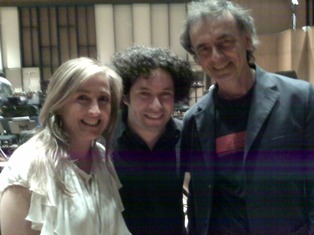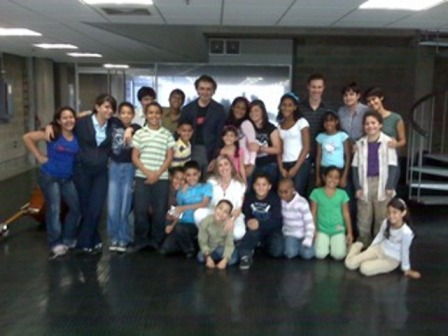Click here for Part Four
Caracas, April 13
Another day of wonders and the unpredictable.
Today, Diana Arismendi, head of El Taller de Escritura Creativa, the Center for Creative Writing, and a prominent Venezuelan composer, returns from Puerto Rico to help us organize our efforts. I need her to feel that our program of starting kids composing at a very early age will help her own efforts to bring composers more into prominence in the El Sistema curriculum, and in general, to further the national creative spirit.
Last night, Dani had asked me a very searching question: “If you say that these children already have it in them to compose, then exactly what is it that you give them?” An excellent question, deserving of a serious answer. So I write out to her a little essay in the form of numbered points. The Tools of Creativty by Jon Deak, April 10, 2010.pdf. (Don’t worry, it’s in English!)
Things are happening! We managed to get the main percussion “Profe” here to demonstrate all his instruments for the Young Composers. I told him that what we mainly wanted was for the kids to “interview” the instruments by asking questions of them and even playing them themselves. He seemed a bit surprised, but quite willing, and we all had a lot of fun listening to each other improvise short solos on the bongos, congas, woodblocks, guiro, toms, and many more. Some of the most shy kids had the very most interesting ideas. I wonder if these bursts of rhythmic swagger will translate in their own works. By the way, the Professor, Ivan Hernandez, along with every percussionist I ever see, says to say hello to Chris Lamb of the Philharmonic, along with Diana Arismendi and Alfredo Rugeles, the conductor. He must have made some impression here!
Back upstairs to go over interval and chord sentiment, recognition, getting them to become excited by the qualities of melodies with tiny intervals, perfect intervals, minor sevenths (space, yearning, canyon, anger) and types of dissonances. They seem to respond strongly to dissonances. All kids do, but this group seems much more inclined.
only about half of the students reliably hear the difference between a minor and a diminished chord. Am I doing something wrong here? They sing and solfege so well. There’s just no way to predict the path of learning here. Somehow this is comforting and even exciting. We play a bit more rhythmic games, and they have great ability, yet does this translate into musical creativity?
Splitting up into small groups, we are able to focus more on individuals. Part of my process when students are at this stage, and especially with a large group like this, is to document the process by xeroxing, photocopying their sketches.Then Richard, Pedro and I can go over the results afterward and ask more informed questions next time. But we were told yesterday, the xerox machines were closed!! Today, ¡No se puede hacer impresiones! The orchestra has an urgent need and has commandeered all the machines! Believe me, after so many decades of working with professional orchestras across continents, I know better than to tangle with a librarian!
Notation, notation! Where’s that blackboard? Why are there so many obstacles involved in creativity, most notably the mind itself? Richard is completely tied down in his group by José Gregorio (age nine), who is acting out again. Maybe we should hire babysitter? Diana is wonderful, yet struggling a bit with such an energetic group of small kids–ordinarily she teaches on the University level. I am convinced Mailyn (12) is trying to please me–she’s too self-conscious to listen to herself.
Perhaps we can’t do this after all. Perhaps we’re kidding ourselves. And yet, look at the masterful work Luis is bringing to life. And Oscar. And from Irawo, between his acting out, we get bursts of wild, wonderful, expressive sounds in clumps and bunches. He gets excited, focused, follows a marvelous line, and then suddenly runs off, misbehaves, gets into a fight. But look at the wonderful viola line Daniela is developing, slowly moving to weave a texture with the other instruments. We look over her shoulder, and she hides her work. Girls in the corner with cellphones. Out, out! ¡Afuera, apagarlos! I wonder if non-composing musicians realize how messy creativity can be.
Fortunately, order comes of this chaos. Much good work and progress has been made today. I only hope they don’t lose their manuscripts or forget them tomorrow, because we have no copies. We were told they would never have time nor the type of home situations where composing at night could take place. Yet they clearly are doing work and making progress between classes. Some of them have written three or four pieces!
Exhaustion.
Richard and I spend hours going over this progress, discussing techniques, talking with Diana, Dani and Pedro (23), who is beginning to show leadership and dedication. Richard is battling sickness bravely. He has been absolutely charming to everyone with his expert abilities, brightness, and gentle humor. But alas, he may have to go directly to bed, and miss this concert we’ve all been looking forward to.
My head is spinning.
— Jon Deak
Click here for Part Six
**************************************************************************************************************
Jon Deak, born in the sand dunes of Indiana of East European parents, is a Composer, Contrabassist, and Educational pioneer. Educated at Oberlin College, the Julliard School, the Conservatorio di Santa Cecilia (Rome) and the University of Illinois, he joined the New York Philharmonic and served as its Associate Principal Bassist for many years, while continuing his professional composing, and studying with Pierre Boulez and Leonard Bernstein. During this time he also introduced ground-breaking performance techniques for the Contrabass, and in his orchestral writing, working with major orchestras across the country.
From 1994 – 97 he served as Composer In Residence (sponsored by Meet the Composer) with the Colorado Symphony under Marin Alsop, which is where he initiated the public school program now called The Very Young Composers (VYC).
With support from the New York Philharmonic and others, the VYC has grown steadily, winning a national award for excellence in 2004. The program has been introduced in Shanghai, Tokyo, and now in Venezuela, besides serving hundreds of children in eleven New York area Public Schools and such places as New England and Eagle County, Colorado. The New York Philharmonic has premiered 42 works for children, fully orchestrated by the children themselves, mostly under the ages of 13, as well as hundreds of chamber works in the public schools and libraries.

Daniela Bedoni, Guztavo Dudamel, and Jon Deak

Daniela Bedoni, Richard Mannoia, and Jon Deak with children from El Sistema
 blog | AJBlog Central | Contact me | Advertise | Follow me:
blog | AJBlog Central | Contact me | Advertise | Follow me: 

